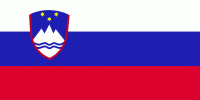Slovenia – climate and energy statistics
Posted in National and regional statistics on 08/28/2010 02:22 pm by Stephen Tindale Change in annual greenhouse gas emissions since 1990
Change in annual greenhouse gas emissions since 1990
– 15.4% including land use change. (Without land use change +1.2%.)
2005 per capita annual greenhouse gas emissions
10.1 tonnes without land use change.
Energy intensity
Slovenia has lower energy use per unit of GDP than other central and eastern European countries. This is mainly because it has a large services sector, which is not energy intensive.
Balance of energy sources, 2007
| % | |
| Oil | 35 |
| Coal* | 22 |
| Nuclear | 20 |
| Gas | 12.5 |
| Renewables | 6.5 |
| Hydro | 4 |
Energy security
“Slovenia has no significant primary energy resources. Its only indigenous energy reserves are proven oil reserves of less than 50 million barrels and 51.8 Mtce of lignite.
“Since its creation in 1991, the Republic of Slovenia has recorded a steady economic upturn and, between 1996 and 2006, the country’s primary energy consumption increased by 17% to reach an approximate figure of 10.7 Mtce. Oil has the biggest share of this market, with 24%, followed by coal with 21% (imported hard coal accounts for 4% and domestic lignite for 17%), nuclear energy with 19%, and natural gas with 13%. Approximately 53% of the country’s primary energy requirements is met by imports. Around 60% of these fuel imports is oil and around 20% is gas. From 2000 to 2006, imports of primary energy increased by 18%, and in the same period of time, indigenous energy output rose by almost 10%.”
(See Euracoal: Greece.)
Electricity generated, 2007
| % | |
| Nuclear | 38 |
| Coal | 36.5 |
| Hydro | 22 |
| Waste | 5 |
| Gas | 3 |
| Biomass | 0.75 |
| Oil | 0.2 |
Fuels used for heat, 2007
| % | |
| Coal | 64 |
| Gas | 30 |
| Biomass | 4 |
| Oil | 1.5 |
Percentage of agriculture certified as organic
4.55%
Cars per thousand of population
413


